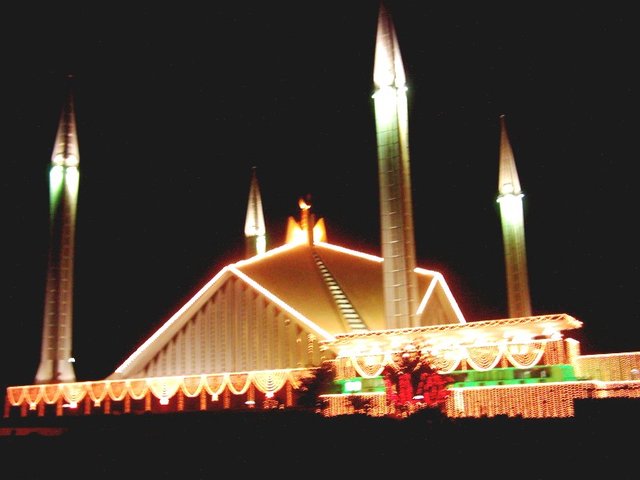ShahFaisalMosque-Islamabad
The impetus for the mosque began in 1966 when King Faisal bin Abdul-Aziz supported the initiative of the Pakistani Government to build a national mosque in Islamabad during an official visit to Pakistan.
Shah Faisal Masjid, also known as Faisal Mosque, located in the start of Margala hill sector E-7 Islamabad Pakistan
The mosque's unusual design is a departure from the long history of South Asian Islamic architecture, fusing contemporary lines with the more traditional look of an Arab Bedouin's tent, with its large triangular prayer hall and four minarets. However, unlike traditional masjid design, it lacks a dome. The minarets borrow their design from Turkish tradition and are thin and pencil like.
Interior of Faisal Mosque
The shape of the Faisal Mosque is an eight-sided concrete shell inspired by a desert Beduoin's tent and the cubic Kaaba in Mecca, flanked by four unusual minarets inspired by Turkish architecture. The architect later explained his thinking to design school students:[10]
“ I tried to capture the spirit, proportion and geometry of Kaaba in a purely abstract manner. Imagine the apex of each of the four minaret as a scaled explosion of four highest corners of Kaaba – thus an unseen Kaaba form is bounded by the minarets at the four corners in a proportion of height to base. Shah Faisal Mosque akin to Kaaba.
Now, if you join the apex of each minaret to the base of the minaret diagonally opposite to it correspondingly, a four-sided pyramid shall be bound by these lines at the base side within that invisible cube. That lower level pyramid is treated as a solid body while four minarets with their apex complete the imaginary cube of Kaaba.
”
Entrance is from the east, where the prayer hall is fronted by a courtyard with porticoes. The International Islamic University was housed under the main courtyard, but recently relocated to a new campus. The mosque still houses a library, lecture hall, museum and cafe. The interior of the main tent-shaped hall is covered in white marble and decorated with mosaics and calligraphy by the famous Pakistani artist Sadequain, and a spectacular Turkish-style chandelier. The mosaic pattern adorns the west wall, and has the kalimah written in early Kufic script, repeated in mirror image pattern.

Hi! I am a robot. I just upvoted you! I found similar content that readers might be interested in:
https://en.wikipedia.org/wiki/Faisal_Mosque
nice bro
thanks bro
good post follow me i followed you and also upvote
thank you
good dost